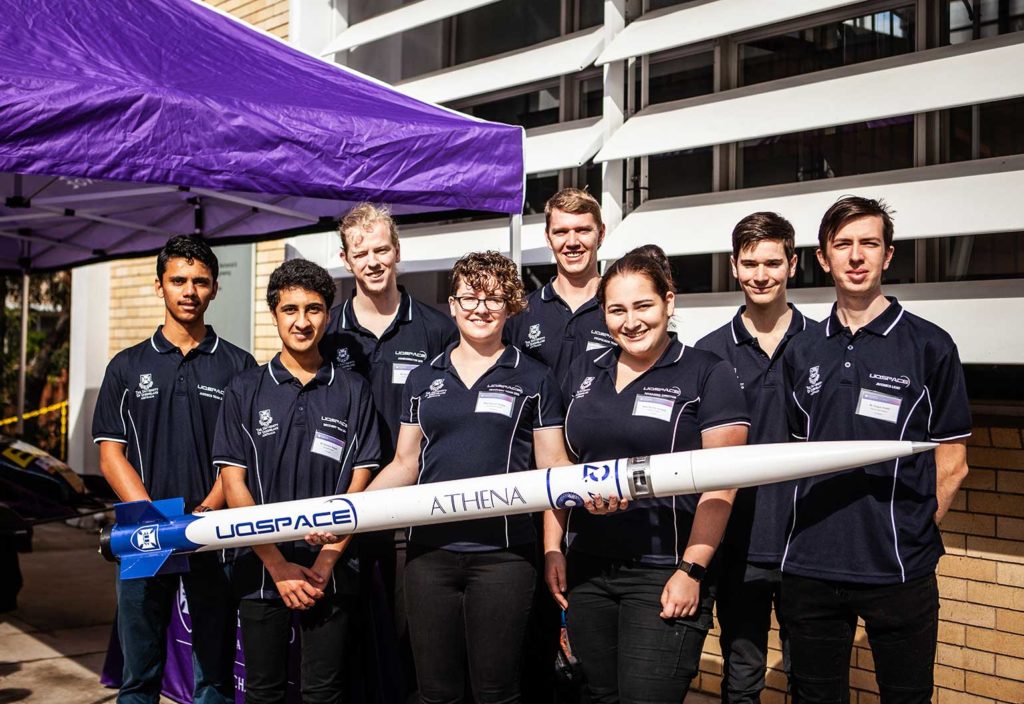University of Queensland engineering students have designed and built a rocket that will blast off next year — and hopefully set a new record as the first university to fly a student-built rocket and scientific payload into space.
Dubbed ‘Project Asteria’, student organisation UQ Space is developing a rocket that will zoom past the Kármán Line, 100 kilometres above sea level, reaching speeds greater than Mach 5.
UQ Space Managing Director, mechanical engineering and political science student Myrthe Snoeks, said the team took a systems engineering approach to creating the rocket.
“We focused on creating a sustainable project lifecycle and the highest probability of success,” she told create.
“The UQ Space team works with a multitude of sub-teams and divisions based on core components, including aerostructures, avionics, propulsion, payload, recovery, systems and manufacturing, allowing specialised skill development while collaborating on effective system integration.”
Snoeks is one of the several students who founded the UQ student rocketry club, UQ Space. They are advised by key academics and researchers, and work with the university’s workshop staff to design and build rockets. Industry partners include Queensland-based Black Sky Aerospace.
“Preliminary design and prior art research were foundational to engineering this rocket, which is followed by preliminary design reviews, extensive further testing and manufacturing, critical design reviews, flight readiness review and many other milestones,” Snoeks added.
She said that it was by far the most complex system that she and the 90-strong student team had ever worked on.
“Many factors were at play in making this project a success — from team engagement to risk management and launch applications, as well as composite manufacturing, destructive testing and simulations,” she said.
The project came about after the UQ Space team won the Australian Universities Rocket Competition in 2019, and this year, decided to aim higher.
Snoeks said that having the opportunity to work with industry partners on such a big project had been a great chance to apply what she had learnt during her studies before entering the workforce.
“I believe that working on challenging projects such as Project Asteria will give us a head start in most industries, from business and consulting to engineering and manufacturing,” she said.
“We now have extensive practical experience, as well as word-class theoretical knowledge.”
Power of partnerships
Apart from the challenge of moving the project online due to COVID-19, the students had to overcome a range of more traditional engineering obstacles.
“Designing, simulating and manufacturing a vehicle that will exceed speeds of Mach 5 brings a multitude of technical challenges, including material selection to telemetry and avionics,” Snoeks said.
“That’s where the collaboration with industry becomes particularly valuable, allowing us to call on a wealth of knowledge to work towards solutions.”
The project is one of the first industry collaborations to take advantage of the $3 million commitment from Black Sky Aerospace and Beyond the Blue Aerospace to encourage space ventures in Queensland.
A spokesperson for Black Sky Aerospace said the firm was excited to be working with the UQ Space students on the initiative.
“It’s the largest university rocket of its kind in diameter, length, weight and payload capability, and of course engine power, which brings with it a number of challenges,” he told create.
“This rocket will be significantly more powerful than its predecessors, and as a result is much less forgiving. The margins for error are small, so the engineering needs to be comprehensive.”
The project will use the Beyond the Blue Aerospace launch and test facility near Goondiwindi in western Queensland, known as ‘Funny Farm Space’. The facility is Australia’s only sub-orbital facility permitted to fly through and above controlled airspace and was home to Australia’s first commercial payload rocket launch by Black Sky Aerospace in 2018.
“Doing something that has never been done before has challenges at every corner — it’s partially what makes this such a fantastic learning opportunity,” Snoeks said.
